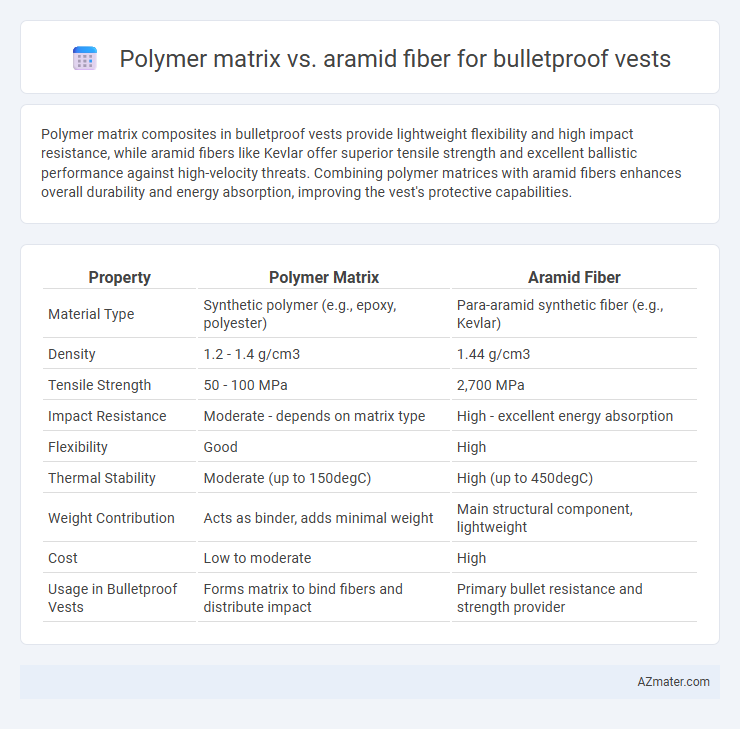Polymer matrix composites in bulletproof vests provide lightweight flexibility and high impact resistance, while aramid fibers like Kevlar offer superior tensile strength and excellent ballistic performance against high-velocity threats. Combining polymer matrices with aramid fibers enhances overall durability and energy absorption, improving the vest's protective capabilities.
Table of Comparison
| Property | Polymer Matrix | Aramid Fiber |
|---|---|---|
| Material Type | Synthetic polymer (e.g., epoxy, polyester) | Para-aramid synthetic fiber (e.g., Kevlar) |
| Density | 1.2 - 1.4 g/cm3 | 1.44 g/cm3 |
| Tensile Strength | 50 - 100 MPa | 2,700 MPa |
| Impact Resistance | Moderate - depends on matrix type | High - excellent energy absorption |
| Flexibility | Good | High |
| Thermal Stability | Moderate (up to 150degC) | High (up to 450degC) |
| Weight Contribution | Acts as binder, adds minimal weight | Main structural component, lightweight |
| Cost | Low to moderate | High |
| Usage in Bulletproof Vests | Forms matrix to bind fibers and distribute impact | Primary bullet resistance and strength provider |
Introduction to Bulletproof Vest Materials
Bulletproof vests primarily utilize polymer matrix composites and aramid fibers to achieve superior ballistic protection. Polymer matrices, such as ultra-high-molecular-weight polyethylene (UHMWPE), provide lightweight flexibility while effectively dispersing impact forces. Aramid fibers like Kevlar exhibit exceptional tensile strength and thermal stability, making them integral in multilayered ballistic systems to prevent penetration and blunt trauma.
Polymer Matrix: Composition and Properties
Polymer matrix materials in bulletproof vests primarily consist of thermosetting resins such as epoxy, polyester, or vinyl ester, which serve as a binding agent for reinforcing fibers. These matrices provide high tensile strength, excellent durability, and resistance to impact and environmental degradation, enhancing the overall performance of the composite armor. The polymer matrix's ability to distribute stress and maintain fiber alignment is crucial for maximizing energy absorption and improving ballistic protection against high-velocity projectiles.
Aramid Fiber: Structure and Advantages
Aramid fibers, such as Kevlar, consist of long chains of polyamide molecules with rigid molecular backbones that provide exceptional tensile strength and thermal stability. The molecular structure creates strong intermolecular hydrogen bonding, resulting in high resistance to impact and ballistic threats, making aramid fiber ideal for bulletproof vests. Compared to traditional polymer matrix materials, aramid fibers deliver superior energy absorption and lightweight protection, enhancing wearer mobility and comfort in ballistic armor applications.
Ballistic Protection: Polymer Matrix vs Aramid Fiber
Polymer matrix composites in bulletproof vests offer enhanced rigidity and energy absorption, improving ballistic protection against high-velocity projectiles. Aramid fibers like Kevlar provide superior tensile strength and flexibility, allowing them to dissipate energy effectively while maintaining lightweight comfort. Combining polymer matrices with aramid fibers often results in optimized multi-layered vests that maximize both durability and impact resistance performance.
Weight and Comfort Comparison
Polymer matrix composites used in bulletproof vests are generally lighter than traditional aramid fiber materials, enhancing wearer mobility and reducing fatigue during extended use. Aramid fibers, such as Kevlar, offer excellent ballistic resistance but tend to be heavier and less breathable, which can compromise comfort in hot environments. Advances in polymer matrix technology have improved flexibility and moisture-wicking properties, making these vests more comfortable while maintaining comparable protection levels.
Durability and Environmental Resistance
Polymer matrix materials in bulletproof vests offer notable durability with high resistance to moisture and UV radiation, maintaining structural integrity under prolonged environmental exposure. Aramid fibers, such as Kevlar, excel in impact resistance and tensile strength but are more susceptible to degradation from UV exposure and moisture absorption. Balancing polymer matrix resilience and aramid fiber performance is critical for optimal bulletproof vest longevity in diverse environmental conditions.
Flexibility and Ergonomics
Polymer matrix composites offer superior flexibility and lightweight properties, enhancing the ergonomic fit and comfort of bulletproof vests during extended wear. Aramid fibers, such as Kevlar, provide high tensile strength and durability but are generally stiffer, which can limit mobility and reduce wearer comfort. Optimizing a vest's design often involves balancing the polymer matrix's flexibility with the aramid fiber's protective strength to achieve maximum ergonomic performance.
Cost Analysis of Polymer Matrix and Aramid Fiber Vests
Polymer matrix vests generally offer a lower production cost compared to aramid fiber vests due to the affordability of raw materials like polyethylene and polypropylene used in their composition. Aramid fiber, particularly Kevlar, involves higher manufacturing expenses driven by complex chemical synthesis and stringent quality control processes. While polymer matrix vests provide cost-effective ballistic protection, aramid fiber vests justify their premium price with superior durability and enhanced multi-hit performance.
Real-World Applications and Case Studies
Polymer matrix composites, such as UHMWPE, are widely used in bulletproof vests for their lightweight and high tensile strength, enabling enhanced mobility for law enforcement and military personnel. Aramid fibers like Kevlar offer exceptional thermal stability and energy absorption, proven effective in multiple case studies involving ballistic threats, including handgun and rifle rounds. Real-world applications demonstrate that combining polymer matrix composites with aramid fibers often results in vests that balance flexibility, durability, and superior ballistic protection.
Future Trends in Ballistic Vest Materials
Polymer matrix composites and aramid fibers remain critical in the development of next-generation bulletproof vests, driven by advancements in nano-engineered polymers and hybrid fiber integration. Emerging materials such as graphene-enhanced polymer matrices and bio-inspired aramid fiber composites offer improved impact resistance, weight reduction, and thermal stability, responding to evolving ballistic threats. Research in scalable manufacturing techniques and multifunctional ballistic fabrics is accelerating the transition toward lighter, more flexible, and higher-performing protective gear.

Infographic: Polymer matrix vs Aramid fiber for Bulletproof vest
 azmater.com
azmater.com